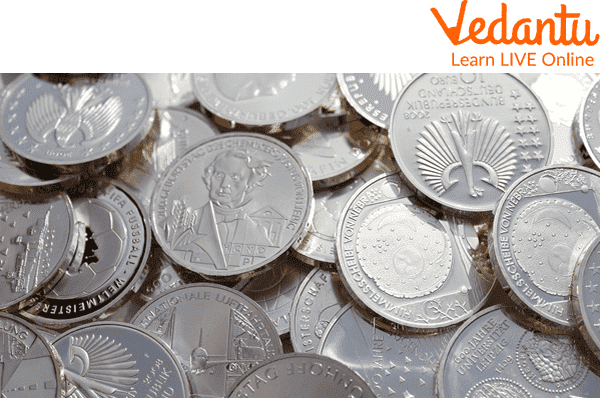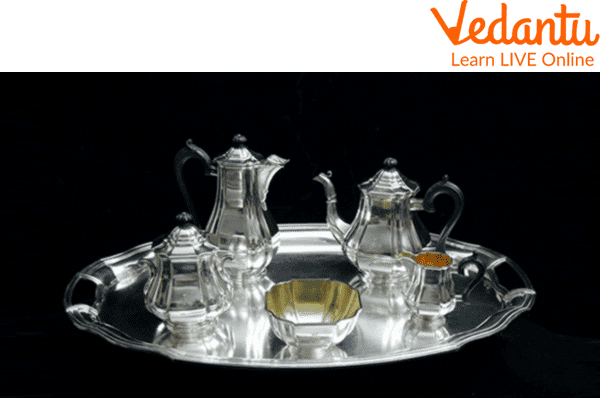




Real-World Applications and Unique Qualities of Silver
Hello kids, have you ever wondered that the greyish colour jewellery your mother is wearing is made up of which metal? The metal is silver.
Before that, let us discuss what metals are. Metals such as iron, lead or silver are underground minerals found in rocks. Heat is used to separate them from the rocks. Metals are excellent building materials. Strength and hardness are just a few of the qualities that metals possess. Metals can be heated and formed into anything, from a little paperclip to a huge aeroplane.
Similarly, silver has been used for different uses over the years, including jewellery, photography, and electronics. In ancient times, coins and utensils comprised silver. Further, we will discuss the uses of silver, silver facts, and its properties.

Silver Coins
Properties of Silver
The properties of silver are as follows:
Symbol: Ag
Atomic Number: 47
Atomic Weight: 107.8682
Classification: Transition Metal
Phase at Room Temperature: Solid
Density: 10.49 grams per cm cubed
Melting Point: 961°C or 1763°F
Boiling Point: 2162 °C or 3924°F
In the periodic table's eleventh column, silver is the second element. It falls within the transitional metal category. The most common isotope of silver atoms contains 60 neutrons along with 47 protons and electrons.
Silver is a hard metal with a glossy metallic lustre. It is very malleable and ductile. Ductility is a property of metal, in which the metal can be pulled into wires. Malleability means the metal can be hammered into flat sheets.
Of all the metals, silver has the highest electrical and thermal conductivity. Silver is an extremely shiny metal which reflects 95% of all visible light. Many mirrors are coated with silver because of the high reflective property of silver. Additionally, it is also used in solar panels, telescopes, and microscopes.
Silver is a less reactive metal. However, coming in contact with sulphur compounds, they will react and turn into a tarnish colour.
Uses of Silver
Given below are the uses of silver.
Silver was used in the past to make coins. Since ancient times, silver has been used as currency. Due to its high price, silver is no longer used to make coins.
Because of its high electrical conductivity, silver is used in the electronic industry. Most of its applications are in high-end ones where copper, a more affordable metal, is ineffective. Batteries having a long life are also made up of silver.
Besides these uses, silver is also used in nuclear reactors, mirrors, dental fillings, and musical instruments.

Silver Utensils
Interesting Facts About Silver
Some interesting facts about silver are as follows:
The pound sterling, which is the name of United Kingdom's official currency, used to be worth one pound of silver.
Around 30% of the silver produced until the invention of digital cameras was used for photography in the compound form silver nitrate.
To produce rain, clouds are seeded with the silver complex silver iodide (AgI).
Because they can help stop the growth of bacteria and fungi, silver nanoparticles are sometimes applied to garments.
Silver can kill germs, therefore in the past, it was common practice for wealthier families to feed their children with silver spoons, which resulted in healthier children.
Summary
In this article, we learned that silver is the second element in the periodic table and falls within the transitional metal category. It is a soft metal with a glossy metallic lustre and is very malleable and ductile. We have discussed silver uses, facts, and properties of silver. Silver has been used for different purposes over the years, including jewellery, photography, coins, and electronics. It is a metal with high reflective properties. Silver was also used in ancient times to make coins and utensils, but because of its high price, it is no longer used for this purpose. We hope you enjoyed reading this article.
FAQs on Interesting Facts About Silver Every Student Should Know
1. What makes silver a precious metal?
Silver is considered a precious metal because it is rare in nature and has a high economic value. Throughout history, it has been used as a form of currency, for making jewellery, and in high-value items. Its unique properties, like its brilliant shine and resistance to corrosion, also contribute to its status.
2. What are some common uses of silver in our daily lives?
Silver has many important uses beyond just jewellery and coins. Some common applications include:
- Electronics: It is an excellent electrical conductor, used in switches, circuit boards, and batteries.
- Mirrors: Silver is highly reflective, making it perfect for the coating on the back of high-quality mirrors.
- Medicine: It has antimicrobial properties, so it is used in wound dressings and medical equipment.
- Photography: Silver compounds were essential for developing traditional photographic film.
3. Which country produces the most silver in the world?
The world's leading producer of silver is Mexico. The country has a long history of silver mining and consistently produces the highest volume of the metal globally, followed by countries like Peru and China.
4. Where is silver naturally found on Earth?
Silver is naturally found in the Earth's crust, but it is quite rare. It can be found in its pure, native form as nuggets or flakes, but it is more commonly extracted from ores like argentite. It is often mined as a by-product of processing other metals such as copper, lead, and zinc.
5. Why doesn't silver rust like iron?
Silver does not rust because rusting is a specific type of corrosion (oxidation) that happens to iron and steel. Instead of rusting, silver tarnishes. Tarnish is a thin layer of corrosion (silver sulfide) that forms on the surface when silver reacts with sulfur compounds in the air. Unlike rust, which eats away at the metal, tarnish only affects the surface and can be polished off.
6. Why is silver not magnetic?
Silver is not magnetic because of its atomic structure. Magnetism in metals like iron, nickel, and cobalt is caused by the specific alignment of electrons, creating a strong magnetic field. The electron configuration in silver atoms does not allow for this kind of alignment, so it is classified as a diamagnetic material, meaning it is actually weakly repelled by a magnetic field.
7. If silver is the best electrical conductor, why are copper and aluminium used more for wires?
Although silver is the best conductor of electricity, it is not widely used for wiring primarily due to its high cost and rarity. Copper and aluminium are much more abundant and affordable, making them the more practical and economical choice for manufacturing electrical wires for homes and industries. Copper offers excellent conductivity at a fraction of the cost of silver.
8. What does it mean for silver to be malleable and ductile?
These two terms describe important physical properties of silver. Malleability is the ability of a metal to be hammered or pressed into thin sheets without breaking. Silver is one of the most malleable metals. Ductility is the ability to be stretched into a thin wire. Silver's high ductility allows it to be drawn into fine wires for use in jewellery and electronics.









